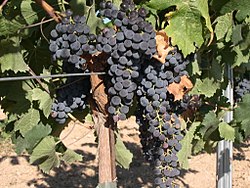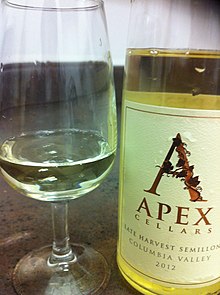Washington wine
Muscat Canelli, Muscat Ottonel, Petit Verdot, Pinot blanc, Pinot gris, Pinot noir, Riesling, Roussanne, Sangiovese, Sauvignon blanc, Sémillon, Siegerrebe, Syrah, Viognier, Zinfandel[1] |
Washington wine is a
The early history of the Washington wine industry can be traced to the introduction of
History

The earliest grape vines planted in Washington State were at Fort Vancouver in 1825 by traders working for the Hudson's Bay Company but it is not known for sure whether the wine was ever produced from these plantings.[14] Currently, a number of wineries and vineyards operate in the region near Fort Vancouver in Clark County, Cowlitz County, and parts of Skamania County and Lewis County.
The first people who were definitely known to produce wine were German and Italian immigrants who planted their wine grapes in Washington during the 1860s and 1870s.
The roots of the modern Washington wine industry can be traced to the middle of the 20th century when a group of professors from the University of Washington turned their home winemaking operation into a commercial endeavor and founded Associated Vintners (later renamed Columbia Winery) and focused on producing premium wines. The Nawico and Pommerelle wineries were merged into a new winery that would eventually become Chateau Ste Michelle. With the hiring of André Tchelistcheff as a consultant, Chateau Ste Michelle and Associated Vintners became the driving force in premium wine production for the early modern Washington wine industry.[15] Grenache was one of the first Vitis vinifera grapes to be successfully vinified with a 1966 Yakima Valley rosé earning mention in wine historian Leon Adams's treatise The Wines of America.[17] The 1970s ushered in a period of expansion, with early vineyards being planted in the Columbia Gorge, Walla Walla and Red Mountain areas. The 1978 Leonetti Cellars Cabernet Sauvignon was featured on the cover of a national wine publication and touted as the best Cabernet of vintage. The 1980s saw further expansion with the opening of large-scale family-owned wineries such as Woodward Canyon, L'Ecole N°41, Barnard Griffin and Hogue Cellars that soon won many awards from both national and international wine competitions. In 1988, Chateau Ste Michelle was named "Best American Winery" and in 1989 five Washington wines made Wine Spectator's "Top 100 list" for the first time.[16]

Following the broadcast in 1991 of the
Geography and climate
The Cascade Mountain range is a defining feature in both the geography and climate of Washington state. It serves as a dividing line between the wet,
Today the
Viticulture

Viticulture in Washington State is deeply influenced by the use of irrigation and the water rights associated with suitable vineyard land.
Until recently, there has been very little

Irrigation
While the use of irrigation is disparaged or even prohibited in many premium
Wine regions

Geographically and viticulturally, Washington is divided into sections separated by the Cascade Mountain chain. The cooler, wetter Western Washington which includes the population centers of
Columbia Valley AVA

The large

The
The
In April 2009 the
In 2012 the
Yakima Valley AVA
The Yakima Valley AVA was established in 1983 and is the oldest agricultural region in the state. The third-largest AVA, the area is responsible for more than 40% of the state's entire wine production. Located within the larger Columbia Valley AVA, the Yakima Valley AVA is further sub-divided into the smaller Red Mountain, Snipes Mountain and Rattlesnake Hills AVAs[7] Of the region's 665,000 acres (269,000 ha), nearly 11,120 acres (4,500 ha) were planted as of 2008.[5] Within the larger AVA are vineyards planted in some of the coolest regions in Eastern Washington[20] including Boushey Vineyard.[23] The boundaries of the AVA are framed from the foothills of the Cascade Mountains to the west and follows the path of the Yakima Valley to Red Mountain which shapes its eastern border. The Rattlesnake Hills and Horse Heaven Hills frame the AVA to the north and south, respectively.[15] The Yakima Valley is home to the state's highest concentration of wineries.[14]
The

The Rattlesnake Hills AVA was established in 2006 amidst some controversy about whether the terroir of the region was sufficiently different from that of the greater Yakima Valley AVA.[21][24] Of the region's 68,500 acres (27,700 ha), nearly 1,235 acres (500 ha) were planted as of 2008.[5] The appellation covers the northern expanse of the Yakima Valley and features the highest elevation in the valley ranging from 850 feet (260 m) to 3,000 feet (910 m). Regional temperatures are moderate during the peak growing season but are significantly warmer in winter when compared to other parts of the Columbia Valley (an average of 8-10 degrees Fahrenheit), limiting the frost danger in the appellation.[21]
The
Walla Walla Valley AVA

The
Other regions

The Columbia Gorge AVA was established in 2004. Of the region's 179,200 acres (72,500 ha), nearly 445 acres (180 ha) were planted as of 2008.[5] Similar to the Columbia Valley and Walla Walla AVAs, this appellation also crosses over the southern Washington border into Oregon where Pinot noir and Pinot Gris are grown. Located along the Columbia River where it bisects the Cascade Range, parts of the AVA fall within a wind tunnel that is a popular tourist destination for wind surfing but can be too fierce for viticulture. Most of the vineyards planted on the Washington side of the appellation are located on southward facing slopes along the river where they can receive some protection from the winds. Depending upon the elevation, vineyards in the Columbia Gorge AVA receive anywhere from 18-30 inches (46-76 centimeters) of rain annually.[21]
The Puget Sound AVA is the only wine-growing region located in Western Washington. Of the region's 4.75 million acres (1.9 million hectare), only 200 acres (81 ha) were planted as of 2008 – mostly to cool weather varieties like Madeleine Angevine, Chardonnay, Pinot Gris, Pinot noir and Siegerrebe.[5] Granted AVA status in 1995, the appellation extends from the foothills of the Cascades to the Olympic Peninsula and islands located in Puget Sound. The climate is greatly affected by the marine influences of nearby Puget Sound and the Pacific Ocean which contributes to mild temperatures, wet winters and dry summers – all of which make it ideal for some cool-climate grape varieties. The region experiences more sunshine than Bordeaux and is drier in average precipitation than Burgundy.[14]
Grape varieties


The early Washington wine industry focused predominately on white wines but in recent years, led by the "
Today there are over 80 grape

Washington State is also home to plantings of some lesser known Vitis vinifera varieties that are used in wine production for some experimental wines and blending. These include
Wines

The wines of Washington State are often characterized by their
Washington produces a full spectrum of wines ranging from mass-produced to premium boutique wines. It also produces nearly every style of wine including rosé,
Challenges in the consumer market

In his book Washington Wines and Wineries: The Essential Guide, Paul Gregutt, a wine writer for The Seattle Times and Wine Enthusiast, found that there is a common perception that Washington does not excel with any particular flagship variety or blend, as is common in most of the world's notable wine regions such as Napa Valley with Cabernet Sauvignon, the Mosel with Riesling, Australia with Shiraz, Chablis with Chardonnay and Pomerol with Merlot-based blends. There is also a perception that Washington wines are more expensive than other New World wine regions despite the fact that the state's two largest producers (Chateau Ste. Michelle and Columbia Winery) focus primarily on value wine production.[32] This may be partly due, as Gregutt noted, to the fact that many consumers think that Chateau Ste. Michelle and Columbia Winery are California wine producers.[33] While some wineries in Washington are large corporate-run businesses, many Washington wineries are small family-run businesses, with production often less than 25,000 gallons per year. Smaller wineries typically sell much or even a majority of their production direct to consumers through tasting rooms.
Despite producing significantly more wine than neighboring
References
- ^ a b "Washington: Appellation Profile". Appellation America. 2007. Archived from the original on July 13, 2009. Retrieved November 14, 2007.
- ^ Bureau of Alcohol, Tobacco and Firearms (ATF), Treasury: 44895–44899. November 13, 1984..
 This article incorporates text from this source, which is in the public domain
This article incorporates text from this source, which is in the public domain - ^ "State Area Measurements and Internal Point Coordinates". United States Census Bureau. U.S. Department of Commerce. 2010. Retrieved December 2, 2023.
- ^ Columbia Valley Winery Association (2007). "Washington Grape Acreage and Winery Survey Results Final: April, 2007". Retrieved November 16, 2007.
- ^ ISBN 978-0841602977.
- ^ "Washington State Wine". Retrieved June 14, 2019.
- ^ (Media Relations). Oregon Wine Board. February 5, 2015.
- ^ ISBN 1-74048-050-3.
- ISBN 0-9719258-5-2.
- ^ "Regions & AVAs". Washington State Wine Commission. Retrieved January 23, 2023.
- ^ "List of Pending AVA Petitions". Alcohol and Tobacco Tax & Trade Bureau.
- ^ "Proposed St Helens AVA". Sip Magazine.
- ^ "List of Pending American Viticultural Areas Petitions". TTB.gov. Alcohol and Tobacco Tax and Trade Bureau (TTB). Retrieved March 4, 2024.
- ^ ISBN 0-7566-1324-8.
- ^ ISBN 1-56305-434-5.
- ^ ISBN 978-0520261389.
- ^ Gregutt (2010), pp.67-68.
- The Associated Press.
- ^ Broberg, Brad (April 1, 2007). "Water rights central to negotiating price for premium wine-growing land". Seattle Business Journal.
- ^ ISBN 978-1845333010.
- ^ a b c d e f g h i j k Gregutt (2010), pp.30-48.
- ^ Perdue, Andy (April 28, 2009). "U.S. approves Lake Chelan AVA". WinePress Northwest. Archived from the original on July 22, 2011.
- ^ Gregutt (2010), pp.85-86.
- ^ Meyer, Harris (May 2, 2008). "Lake Chelan area wineries await federal American Viticultural Area designation". Puget Sound Business Journal.
- ^ Stegemoeller, Ingrid (January 22, 2009). "Washington's Snipes Mountain AVA among oldest wine regions". Wine Press Northwest. Archived from the original on July 18, 2011.
- ^ "Establishment of the Snipes Mountain Viticultural Area (2007R–300P)" (27 CFR 9 [Docket No. TTB–2008–0003; T.D. TTB–73; Re: Notice No. 82] RIN 1513–AB51 Final Rule). Federal Register. 74 (12). Alcohol and Tobacco Tax and Trade Bureau {TTB), Treasury: 3422–3425. January 21, 2009. Archived (PDF) from the original on April 18, 2023.
 This article incorporates text from this source, which is in the public domain.
This article incorporates text from this source, which is in the public domain.
- New York Times.
- ^ ISBN 0-9650834-9-7.
- ^ Washington Vineyard Acreage Report 2006 compiled by USDA National Agriculture Statistics Office, Washington Field Office. This is posted on the Washington Association of Wine Grape Growers Website. Retrieved July 10, 2008.
- ^ "The differences between Washington, Oregon, and Illinois wine". Seattle DINING!. 2010.
- ^ Allison, Melissa (May 5, 2006). "Cup of cheer overflows for Snohomish vintners". Seattle Times. Archived from the original on May 24, 2011.
- ^ a b Gregutt (2010), pp.269-298.
- ^ Gregutt (2010), p.24.
External links
- Washington Wine Commission
- Washington Association of Wine Grape Growers
- Discover the Pacific Northwest Wineries, Breweries and Distilleries
- Viticulture and enology research, education and outreach at Washington State University
- Voice of the Vine: the e-newsletter about the science of Washington wine
- TTB AVA Map

